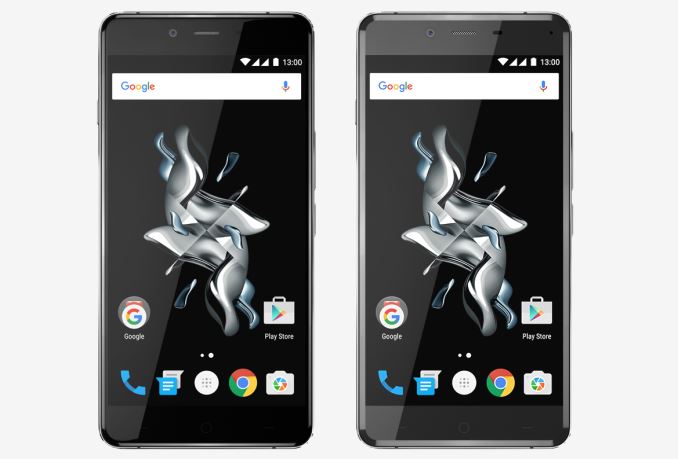OnePlus Launches the OnePlus X
by Brandon Chester on October 29, 2015 6:30 AM EST- Posted in
- Smartphones
- Mobile
- OnePlus

When OnePlus launched the OnePlus Two earlier this year the company also mentioned that they would be launching a second smartphone in 2015, and that the new phone would be announced closer toward the end of the year. With November and the holiday season approaching the phone needed to launch fairly soon to meet that deadline, and today OnePlus has made the new device official. It's the OnePlus X, and it's a smaller addition to the OnePlus family, with a 5.0" display and a completely revamped physical design. You can get all the relevant specifications for the OnePlus X from the chart below.
|
|
OnePlus X |
| SoC | 2.3GHz Qualcomm Snapdragon 801 (MSM8974AB) |
| GPU | Adreno 330 |
| RAM | 3GB LPDDR3 |
| NAND | 16GB + MicroSDXC (No MicroSD on dual-SIM) |
| Display | 5" 1920x1080 AMOLED |
| Dimensions | 140 x 69 x 6.9 mm, 138/160g |
| Camera | 13MP Rear-Facing, f/2.2 8MP Front-Facing OV8858, f/2.4 |
| Battery | 2520 mAh (9.58Wh) |
| OS | OxygenOS/Android 5.1.1 Lollipop |
| Cellular Connectivity | 2G / 3G / 4G LTE (MDM9x25 Category 4) |
| Other Connectivity | 2.4GHz 802.11b/g/n + BT 4.0, microUSB 2.0, GNSS |
| SIM | Nano-SIM (Dual SIM SKU available) |
| Price | Onyx: 249 USD / 269 EUR Ceramic: 369 EUR |
On paper, the OnePlus X does look very similar to the original OnePlus One, but in a smaller form factor. What is probably the most intriguing aspect is the SoC, which is Qualcomm's MSM8974AB. This appears to be a confirmation that Snapdragon 801 can still be sourced, and it's interesting that only OnePlus has decided to utilize it despite the issues with Qualcomm's Snapdragon 808 and 810 SoCs. The OnePlus X uses the 2.3GHz version of Snapdragon 801 rather than the 2.45GHz MSM8974AC used in the OnePlus one, which likely won't have any significant impact in most cases but it's worth pointing out as one of the tiny differences between the two phones
The display is the same resolution as the OnePlus One and OnePlus Two, but with the OnePlus X it has gone down to a 5.0" size. With that also comes a switch from IPS LCD panels to a 1080p AMOLED panel, and it'll be interesting to see if the display has the same level of calibration as the OnePlus One did. The WiFi is strange in that it's advertised as WCN3680, which should be a single spatial stream 802.11ac implementation, but OnePlus only advertises support for 2.4GHz 802.11b/g/n.
While the rear-facing camera is the same resolution as the OnePlus One, it's explicitly stated to be an ISOCELL sensor which confirms that OnePlus has sourced their camera module from Samsung this time around rather than using Sony's IMX214 which was used in the OnePlus One. The front-facing camera gets a bump in resolution from 5MP to 8MP, and uses an Omnivision OV8858 sensor. The lens apertures aren't as wide as the f/2 apertures on the OnePlus One, which will have an impact on low-light shooting performance.
Beyond those changes the OnePlus X looks pretty much like a small OnePlus One as far as the specifications go. Obviously the chassis and display needed to scale down, as did the battery, but these are obvious changes going from a big phone to a smaller one.
The actual design and construction of the phone is a departure from OnePlus's existing industrial design. The OnePlus X drops the exposed plastic and textured back of the OnePlus One and Two, and instead aims for a design made of aluminum and glass. The standard version of the phone has flat metal edges that meet slightly curved glass on both sides, and to me the design looks much more impressive than OnePlus's previous offerings. The phone will also come in two versions, Onyx and Ceramic. The former simply means the black version, while the latter is actually made of ceramic, and also ends up being 22g heavier because of that. The ceramic model will only be sold in limited quantities, with 10,000 being made and sold in Europe and India.
The OnePlus X starts at 249 USD, which is significantly less than the 16GB model of the OnePlus 2 which costs 329 USD. While you definitely do lose a bit as far as specs goes, I actually find the smaller size and new design of the OnePlus X to be much more appealing than the OnePlus Two, and the lower price just makes that look like an even better deal. For anyone interested in buying the OnePlus X you'll still need to get an invite, and it'll be launching in Europe on November 5th for 269 EUR, or 369 EUR if you want the ceramic chassis. In the US the phone will be available on November 11th for 249 USD.












53 Comments
View All Comments
Flunk - Friday, October 30, 2015 - link
Once you pay to get the Xiaomi imported, the cost is pretty similar and you're stuck with a phone that's not supported anywhere but China.LiverpoolFC5903 - Thursday, October 29, 2015 - link
Slight mistake in the specs section. Its Adreno 330 and not 320 (unless QCom have downgraded the GPU to the one used in the SD 600!)The 801 is probably the best soc in terms of performance, battery and general thermal characteristics. It can run anything out there in the android universe with ease and more.
Too bad its considered as 'outdated' because it is not 64 bit. It performs a hell lot better than the range of midrange phones with the SD 615.
Ryan Smith - Thursday, October 29, 2015 - link
"Slight mistake in the specs section. Its Adreno 330 and not 320 (unless QCom have downgraded the GPU to the one used in the SD 600!)"Right you are. Thanks!
Allan_Hundeboll - Thursday, October 29, 2015 - link
Maybe the 5" amoled screen can make up for the smaller battery compared to the original oneplus one with 5.5" IPS screen?Spectrophobic - Thursday, October 29, 2015 - link
Is there a problem with the SD 805? That SoC doesn't get much love. I mean, Adreno 420 is still better than the 418 you find on everyone's favorite SoC, the 808.An 801 is still very capable, but the GPU is just outdated. But hey, at least it's not an octa-core 600-series.
LiverpoolFC5903 - Thursday, October 29, 2015 - link
The 805 probably costs a lot more than the 801.. A cost decision i think.Plus the 805 did have a tendency to run hot, although nowhere as bad as the 810 or 615. In a 5 inch form factor, the thermal load will be more than what the chassis is able to dissipate.
And the Adreno 330 is far from outdated. It beats the gpu in the helio x10 (narrowly though) and is reasonably competent in handling a 2k screen. I believe it can handle 99% percent of games on playstore at high settings. Haventr come across a game that lags on my Find 7a so far.
The adreno 405 on the other hand is ill equipped for 1080p screens. Even the Adreno 320 (snapdragon 600) performs better than it. My 3 year old lg g pro is better able to handle heavy games and apps compared to my wifes X play!!
I would love it if more manufacturers used 800/801 on their mid range models rather than the underwhelming SD 615. It doesnt even have a dual channel memory!
Another possibly great option for mid rangers is the Mtk 6595. It destroys the likes of 615 and mt 6752 (cortex a53 based) in performance. The A17 cores work very well and are less power hungry than the A15...
Anyway, i digress!
Spectrophobic - Thursday, October 29, 2015 - link
I dunno, the 420 was a pretty big jump from the 330. But as you said, the 801 is still a great performer in the real world. It just doesn't quite please the spec junkie in me.It's still a pretty phone (taking cues from Sony) and a 5" 1080p AMOLED screen is exactly what I'm looking for (I love watching anime/videos on pixel dense screens). That's enough for me to accept the 801. But then there's the top-mounted 3.5mm jack, which a big nuisance for me as I put my phone on my pocket upside down (the "ergonomic" way).
phoenix_rizzen - Friday, October 30, 2015 - link
Samsung Galaxy Note 4 in North America uses the SD805 SoC. It's a 5.7" phone, though, so it will have a bit more thermal headroom than a 5" phone. The wife picked one up used a month ago, and it's running quite nicely. Doesn't get hot in the hand for her uses, but she doesn't game on it.nikaldro - Thursday, October 29, 2015 - link
I read an article that showed how the 805 has much less thermal throttling than the 801, which in turn is more stable than the 800. This was due to higher thermal limits, which made it run pretty hot.LiverpoolFC5903 - Friday, October 30, 2015 - link
That makes more sense. It does run hot but does not slow down due to thermal limits kicking in.